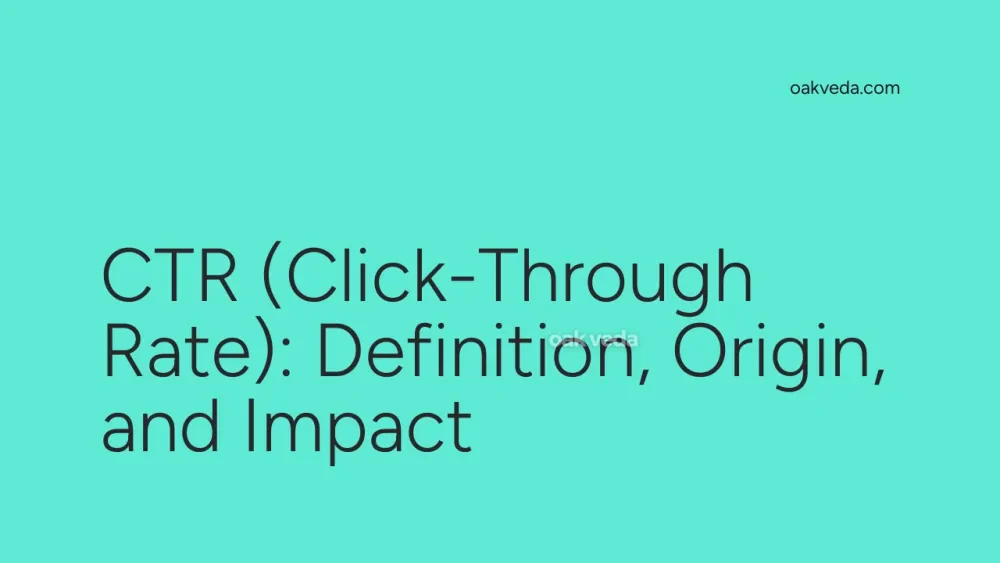
What is CTR?
CTR, or Click-Through Rate, is a crucial metric in digital marketing that measures the effectiveness of online advertising campaigns and content engagement. It represents the percentage of people who click on a specific link or call-to-action out of the total number who view it. In the realm of social media, CTR is particularly important for evaluating the success of ads, posts, and overall campaign performance.
Origin and Development of CTR
The concept of CTR emerged with the rise of digital advertising in the late 1990s and early 2000s. As online platforms evolved and social media gained prominence, CTR became an essential metric for marketers to gauge user interest and engagement. Initially used primarily for banner ads and search engine marketing, CTR has since become a key performance indicator across various digital channels, including social media platforms.
How CTR Works
CTR is calculated by dividing the number of clicks an ad or content receives by the number of impressions (times it was shown) and multiplying by 100 to get a percentage. For example:
- If an ad is displayed 1,000 times (impressions) and receives 50 clicks
- CTR = (50 / 1,000) * 100 = 5%
This simple calculation provides valuable insights into how well your content resonates with your target audience. A higher CTR generally indicates that your ad or content is relevant and appealing to viewers.
Types or Variations of CTR
While the basic concept of CTR remains consistent, there are several variations depending on the platform and context:
- Ad CTR: Specifically measures the performance of paid advertisements.
- Organic CTR: Tracks clicks on non-paid content, such as social media posts or search engine results.
- Email CTR: Measures the effectiveness of links within email marketing campaigns.
- Social Media CTR: Focuses on engagement with posts, stories, or ads on social platforms.
Popular Examples of CTR in Social Media
CTR is widely used across all major social media platforms:
- Facebook: Advertisers use CTR to evaluate ad performance and optimize campaigns.
- Instagram: Brands track CTR on sponsored posts and stories to measure audience engagement.
- Twitter: CTR helps determine the effectiveness of promoted tweets and ad campaigns.
- LinkedIn: B2B marketers rely on CTR to assess the impact of their content and sponsored updates.
Impact of CTR on Social Media Culture
CTR has significantly influenced social media culture by:
- Shaping content creation: Creators and brands focus on producing "clickable" content to improve CTR.
- Influencing algorithm design: Social media platforms often use CTR as a factor in determining content visibility.
- Driving competition: Marketers constantly strive to improve CTR, leading to more engaging and targeted content.
- Affecting user experience: The pursuit of higher CTRs can sometimes lead to clickbait, impacting overall user satisfaction.
Controversies or Debates Surrounding CTR
While CTR is a valuable metric, it's not without controversy:
- Overemphasis on clicks: Some argue that focusing too much on CTR can lead to neglecting other important metrics like conversion rates.
- Click fraud: The prevalence of bots and fake clicks can artificially inflate CTR, leading to misleading data.
- Quality vs. quantity: A high CTR doesn't always translate to high-quality engagement or conversions.
How Brands and Influencers Use CTR
Brands and influencers leverage CTR in several ways:
- Campaign optimization: Continuously adjusting ad copy, visuals, and targeting based on CTR performance.
- Content strategy: Using CTR data to inform future content creation and posting schedules.
- Audience insights: Analyzing CTR across different demographics to better understand audience preferences.
- Competitive analysis: Comparing CTRs with industry benchmarks to gauge relative performance.
Future Trends Related to CTR
As digital marketing evolves, so does the role of CTR:
- AI-driven optimization: Machine learning algorithms will increasingly automate CTR improvement strategies.
- Cross-platform CTR: Marketers will focus more on holistic CTR across multiple channels and touchpoints.
- Video CTR: With the rise of video content, CTR metrics specific to video engagement will gain importance.
- Voice search CTR: As voice-activated devices become more prevalent, new CTR metrics for audio content will emerge.
FAQs about CTR
-
What's considered a good CTR? A good CTR varies by industry and platform. Generally, a CTR of 2-5% is considered decent for display ads, while search ads might aim for 5-10% or higher.
-
How can I improve my CTR? Improve your CTR by crafting compelling headlines, using eye-catching visuals, targeting the right audience, and A/B testing different elements of your content or ads.
-
Is CTR the most important metric in social media marketing? While CTR is crucial, it shouldn't be the only metric you focus on. Conversion rates, engagement rates, and overall ROI are equally important for a comprehensive view of campaign performance.
-
How does CTR relate to SEO? In search engine optimization, a higher CTR can positively influence your rankings. Search engines may interpret a high CTR as a sign that your content is relevant and valuable to users.
-
Can a high CTR be bad? In some cases, yes. If your CTR is high but your conversion rate is low, it might indicate that your ad or content is misleading or not aligned with user expectations after they click.
Understanding and optimizing CTR is essential for success in today's digital landscape. By focusing on creating valuable, relevant content and ads, marketers can improve their CTR while also enhancing overall user experience and campaign effectiveness.
You may be interested in:
- Situationship: Definition, Origin, and Impact
- Banger: Definition, Origin, and Impact in Social Media
- Moots: Definition, Origin, and Impact on Social Media
- Content Calendar: Definition, Origin, and Impact on Social Media
- SRP (Social Relationship Platform): Definition, Origin, and Impact
- Main Character Energy: Definition, Origin, and Impact

